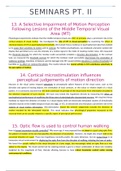Overig
S&Perception - Seminar presentations - Papers' abstracts/summaries
- Instelling
- Universiteit Utrecht (UU)
This file includes the abstracts/summaries of every required readings (papers) for the course Sensation and Perception (Ben Harvey, exam 2). From article 13 to 24, every required paper for the exam is included. The abstracts/summaries are highlighted to help studying more efficiently. For the first...
[Meer zien]




